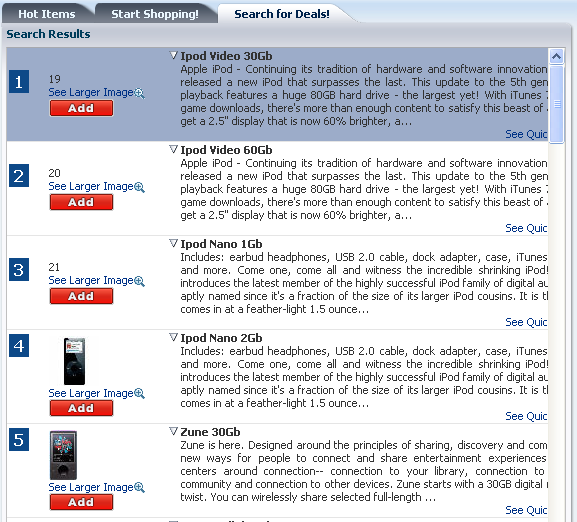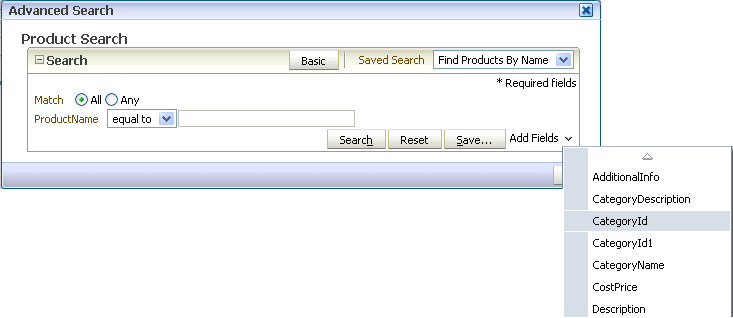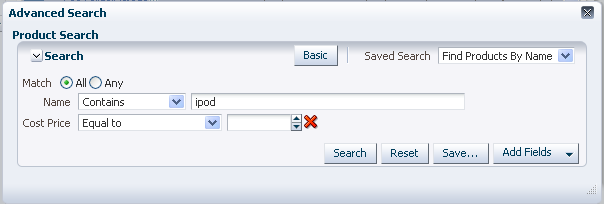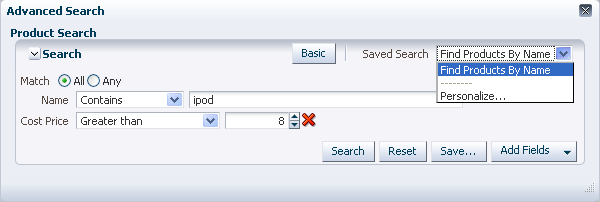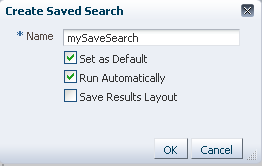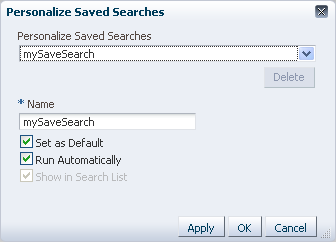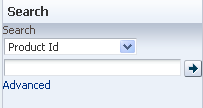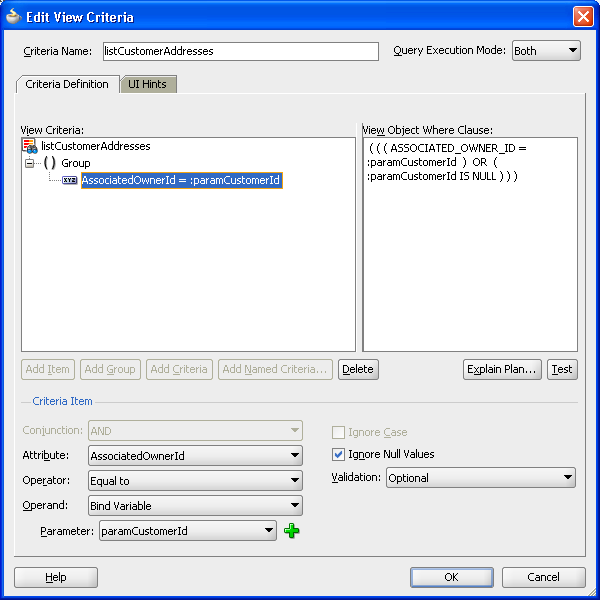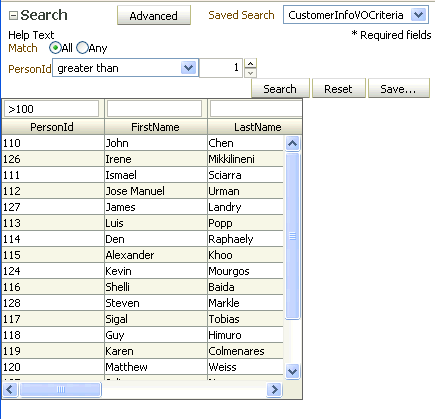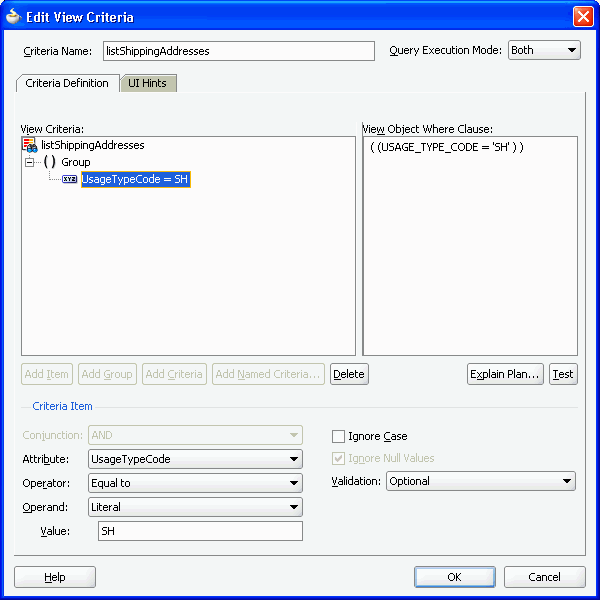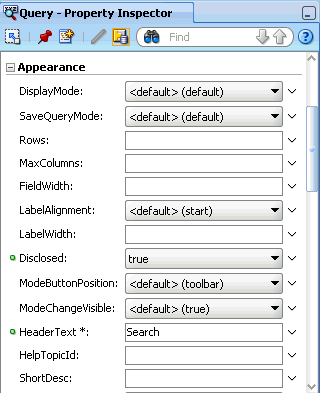27 Creating ADF Databound Search Forms
This chapter describes how to use ADF Faces components and ADF data binding to create search forms to perform complex searches on multiple attributes and search forms to search on a single attribute. For complex query search forms, it describes how to set up the query search form mode, results table, saved searches list, and personalization. For single attribute search forms, it describes how to configure the form layout. In addition, it includes information on using named bind variables and Query-by-Example (QBE) filtered table searches.
This chapter includes the following sections:
27.1 Introduction to Creating Search Forms
You can create search forms that allow users to enter search criteria into input fields for known attributes of an object. The search criteria can be entered via input text fields or selected from a list of values in a popup list picker or dropdown list box. The entered criteria is constructed into a query to be executed. Named bind variables can be used to supply attribute values during runtime for the query. The results of the query can be displayed as a table, a form, or another UI component.
Search forms are based either on view criteria defined in view objects or on implicit view criteria defined by JDeveloper. Search forms are region-based components that are reusable and personalizable. They encapsulate and automate many of the actions and iterator management operations required to perform a query. You can create several search forms on the same page without any need to change or create new iterators.
The search forms are based on the model-driven af:query and af:quickQuery components. Because these underlying components are model-driven, the search form will change automatically to reflect changes in the model. The view layer does not need to be changed. For example, if you define a list of values (LOV) on an attribute in the view object or entity object, the LOV will automatically show up in the search form as an LOV component. Or, if you modify a view criteria to include a new attribute for the WHERE clause, the search panel using this view criteria will automatically reflect that change by adding a search field for that attribute.
Oracle ADF supports two types of search forms: query and quick query. The query search form is a full-featured search form. The quick query search form is a simplified form with only one search criteria. Each of these search forms can be combined with a filtered table to display the results, thereby enabling additional search capabilities. You can also create a standalone filtered table to perform searches without the query or quick query search panel.
A filtered table is a table that has additional Query-by-Example (QBE) search criteria fields above each searchable column. When the filtering option of a table is enabled, you can enter QBE-style search criteria for each column to filter the query results. For more information about tables, see Chapter 23, "Creating ADF Databound Tables."
For more information about individual query and table components, see the "Using Query Components" and the "Using Tables and Trees" chapters of the Oracle Fusion Middleware Web User Interface Developer's Guide for Oracle Application Development Framework.
27.1.1 Query Search Forms
The query search form is the standard form for complex transactional searches. You can build complex search forms with multiple search criteria fields each with a dropdown list of built-in operators. You can also add custom operators and customize the list. The query search form supports lists of values, AND and OR conjunctions, and saving searches for future use.
A query search form has a basic mode and an advanced mode. The user can toggle between the two modes using the basic/advanced button. At design time, you can declaratively specify form properties (such as setting the default state) to be either basic or advanced. Figure 27-1 shows an advanced mode query search form with three search criteria.
The advanced mode query form features are:
-
Selecting search criteria operators from a dropdown list
-
Adding custom operators and deleting standard operators
-
Selecting
WHEREclause conjunctions of eitherANDorOR(match all or match any) -
Dynamically adding and removing search criteria fields at runtime
-
Saving searches for future use
-
Personalizing saved searches
Typically, the query search form in either mode is used with an associated results table or tree table. For example, the query results for the search form in Figure 27-1 may be displayed in a table, as shown in Figure 27-2.
The basic mode has all the features of the advanced mode except that it does not allow the user to dynamically add search criteria fields. Figure 27-3 shows a basic mode query search form with one search criteria field. Notice the lack of a dropdown list next to the Save button used to add search criteria fields in the advanced mode.
In either mode, each search criteria field can be modified by selecting operators such as Greater Than and Equal To from a dropdown list, and the entire search panel can be modified by the Match All/Any radio buttons. Partial page rendering is also supported by the search forms in almost all situations. For example, if a Between operator is chosen, another input field will be displayed to allow the user to select the upper range.
A Match All selection implicitly uses AND conjunctions between the search criteria in the WHERE clause of the query. A Match Any selection implicitly uses OR conjunctions in the WHERE clause. Example 27-1 shows how a simplified WHERE clause may appear (the real WHERE in the view criteria is different) when Match All is selected for the search criteria shown in Figure 27-1.
Example 27-1 Simplified WHERE Clause Fragment When "Match All" Is Selected
WHERE (ProductId=4) AND (InStock > 2) AND (ProductName="Ipod")
Example 27-2 shows a simplified WHERE clause if Match Any is selected for the search criteria shown in Figure 27-3.
Example 27-2 Simplified WHERE Clause Fragment When "Match Any" Is selected
WHERE (ProductId=4) OR (InStock > 2) OR (ProductName="Ipod")
If the view criteria for the query has mixed AND and OR conjunctions between the criteria items, then neither Match All nor Match Any will be selected when the component first renders. However, the user can select Match All or Match Any to override the conjunctions defined as the initial state in the view criteria.
Advanced mode query forms allow users to dynamically add search criteria fields to the query panel to perform more complicated queries. These user-created search criteria fields can be deleted, but the user cannot delete existing fields. Figure 27-4 shows how the Add Fields dropdown list is used to add the CategoryId criteria field to the search form.
Figure 27-5 shows a user-added search criteria with the delete icon to its right. Users can click the delete icon to remove the criteria.
If either Match All or Match Any is selected and then the user dynamically adds the second instance of a search criteria, then both Match All and Match Any will be deselected. The user must reselect either Match All or Match Any before clicking the Search button.
If you intend for a query search form to have both a basic and an advanced mode, you can define each search criteria field to appear only for basic, only for advanced, or for both. When the user switches from one mode to the other, only the search criteria fields defined for that mode will appear. For example, suppose three search fields for basic mode (A, B, C) and three search fields for advanced mode (A, B, D) are defined for a query. When the query search form is in basic mode, search criteria fields A, B, and C will appear. When it is in advanced mode, then fields A, B, and D will appear. Any search data that was entered into the search fields will also be preserved when the form returns to that mode. If the user entered 35 into search field C in basic mode, switched to advanced mode, and then switched back to basic, field C would reappear with value 35.
Along with using the basic or advanced mode, you can also determine how much of the search form will display. The default setting displays the whole form. You can also configure the query component to display in compact mode or simple mode. The compact mode has no header or border, and the Saved Search dropdown lists moves next to the expand/collapse icon. Figure 27-6 shows a query component set to compact mode.
The simple mode displays the component without the header and footer, and without the buttons normally displayed in those areas. Figure 27-7 shows the same query component set to simple mode.
A query is associated with the view object that it uses for its query operation. In particular, a query component is the visual representation of the view criteria defined for that view object. If there are multiple view criteria defined, each can be selected from the Saved Search dropdown list. These saved searches are created at design time and are called system searches. For example, in the StoreFront module of the Fusion Order Demo application, there are two view criteria defined on the ProductsVO view object. When the query associated with that view criteria is run, both view criteria are available for selection, as shown in Figure 27-8.
If there are no explicitly defined view criteria for a view object, you can use the default implicit view criteria.
Users can also create saved searches at runtime to save the state of a search for future use. The entered search criteria values, the basic/advanced mode state, and the layout of the results table/component can be saved by clicking the Save button to open a Save Search dialog, as shown in Figure 27-9. User-created saved searches persist for the session. If they are intended to be available beyond the session, you must configure a persistent data store to store them. For Oracle ADF, you can use an access-controlled data source such as MDS. For more information about using MDS, see Chapter 34, "Customizing Applications with MDS." For more information about user customizations, see Chapter 35, "Allowing User Customizations at Runtime."
Table 27-1 lists the possible scenarios for creators of saved searches, the method of their creation, and their availability.
Table 27-1 Design Time and Runtime Saved Searches
| Creator | Created at Design time as View Criteria | Created at Runtime with the Save Button |
|---|---|---|
|
Developer |
Developer-created saved searches (system searches) are created during application development and typically are a part of the software release. They are created at design time as view criteria. They are usually available to all users of the application and appear in the lower part of the Saved Search dropdown list. |
|
|
Administrator |
Administrator-created saved searches are created during predeployment by site administrators. They are created before the site is made available to the general end users. Administrators can create saved searches (or view criteria) using the JDeveloper design time when they are logged in with the appropriate role. These saved searches (or view criteria) appear in the lower part of the Saved Search dropdown list. |
|
|
End User |
End-user saved searches are created at runtime using the query form Save button. They are available only to the user who created them. End-user saved searches appear in the top part of the Saved Search dropdown list. |
End users can manage their saved searches by using the Personalize function in the Saved Search dropdown list to bring up the Personalize Saved Searches dialog, as shown in Figure 27-10.
End users can use the Personalize function to:
-
Update a user-created saved search
-
Delete a user-created saved search
-
Set a saved search as the default
-
Set a saved search to run automatically
-
Set the saved search to show or hide from the Saved Search dropdown list
Note:
If in you are changing the value of a view criteria item programmatically, you must invoke theViewCriteria.saveState() method to prevent the searchRegion binding from resetting the value of the view criteria item to the value that was specified at design time.27.1.2 Quick Query Search Forms
A quick query search form is intended to be used in situations where a single search will suffice or as a starting point to evolve into a full query search. Both the query and quick query search forms are ADF Faces components. A quick query search form has one search criteria field with a dropdown list of the available searchable attributes from the associated data collection. Typically, the searchable attributes are all the attributes in the associated view object. You can exclude attributes by setting the attribute's Display Hint property in the Control Hints page of the Edit Attribute dialog to Hide. The user can search against the selected attribute or search against all the displayed attributes. The search criteria field type will automatically match the type of its corresponding attribute. An Advanced link built into the form offers you the option to create a managed bean to control switching from quick query to advanced mode query search form. For more information, see the "Using Query Components" chapter in the Oracle Fusion Middleware Web User Interface Developer's Guide for Oracle Application Development Framework.
You can configure the form to have a horizontal layout, as shown in Figure 27-11.
You can also choose a vertical layout, as shown in Figure 27-12.
27.1.3 Named Bind Variables in Query Search Forms
Instead of specifying a literal operand in a view criteria to be used in a search form, you have the option of specifying a named bind variable. The named bind variable performs like a parameter whose value can change at runtime without the need to change the SQL statement. It must be defined in the view object before it can be used in a view criteria.
If you specify a literal operand in the view criteria and leave the value blank, it will not appear in the SQL preview. When the view criteria is applied as a search form at runtime, that attribute is rendered as a blank input search field. If a value is specified for the literal operand, then the SQL preview will generate a SQL clause for it. When the view criteria is applied as a search form at runtime, the SQL statement is not automatically applied even though the value specified in the view criteria appears in the input search field. The SQL statement won't get applied until the user clicks Search (or when auto-execute is set to true).
If a named bind variable is used in the query defined in the view criteria, the SQL preview will display the WHERE clause with the bind variable. When the view criteria is applied as a search form at runtime, the bind variable will be rendered with a prompt and an input search field based on the name of the attribute (not on the name of the bind variable). The named bind variable input field may be NULL, it may contain the default value, or it may contain a value that has loaded from previous processing, such as from another page. The user can enter values for the named bind variable as in any other search criteria. When the search is executed, the value of the named bind variable will be evaluated with the other criteria, as defined by the SQL query statement.
If the bind variable is used more than once in the same view criteria, each occurrence of the bind variable will be rendered as an individual input field. Because there is only one bind variable backing all the input fields, the value of all the fields will be synchronized. For instance, if you specify a view criteria that uses the same bind variable three times, then three input fields will be rendered. When the user enters a value into one input field, the other two input fields will have the same value. Using bind variables in this way eliminates the need for the user to enter the same value multiple times.
Another use of the bind variable is to pass a value from the base row into a search for an LOV search form.
Bind variables can also be used to pass parameter values from one page to another, such as when a customer ID is passed to another page for more detail processing. And, depending on the construct of the SQL statement, using the named bind variable may speed up the query because it may lessen the need to prepare a new statement, which means that the database does not need to reparse. For more information about creating and using named bind variables, see Section 5.10, "Working with Bind Variables."
For example, in the StoreFront module of the Fusion Order Demo application, in the listCustomerAddresses view criteria, the WHERE clause checks to see whether the AssociatedOwnerId is the same as the value of the paramCustomerId named bind variable. This view criteria is in the AddressesLookupVO view object. The listCustomerAddresses view criteria as defined in the Edit View Criteria dialog is shown in Figure 27-13.
A query search form for a view criteria with a named bind variable will render with a search field for the variable using the inputText component. Figure 27-14 shows the AssociatedOwnerId search field displayed as an inputText component.
27.1.4 Filtered Table and Query-by-Example Searches
A filtered table can be created standalone or as the results table of a query or quick query search form. Filtered table searches are based on Query-by-Example and use the QBE text or date input field formats. The input validators are turned off to allow for entering characters such as > and <= to modify the search criteria. For example, you can enter >1500 as the search criteria for a number column. Wildcard characters may also be supported. If a column does not support QBE, the search criteria input field will not render for that column.
The filtered table search criteria input values are used to build the query WHERE clause with the AND operator. If the filtered table is associated with a query or quick query search panel, the composite search criteria values are also combined to create the WHERE clause.
Note:
If the filtered table is used with a query component in a search form and the search region is using an existing named criteria, the results of the query will be filtered by all the view criteria rows in an iterative manner. For example, a filtered table has two view criteria rows:PersonId and DeptId. The first view criteria row has PersonId > 1. When the user enters > 100 in the filter field, then the second view criteria row DeptId is used to accept input to further filter the results. This process iterates through all the view criteria rows until the final query result is reached.Figure 27-15 shows a query search form with a filtered results table. When the user enters a QBE search criteria, such as >100 for the PersonId field, the query result is the AND of the query search criteria and the filtered table search criteria.
Table 27-2 lists the acceptable QBE search operators that can be used to modify the search value.
27.1.5 Implicit and Named View Criteria
When you create data controls, all data collections will automatically include a Named Criteria node with an All Queriable Attributes criteria. This is the default view criteria that includes all the searchable attributes or columns of the data collection. You cannot edit or modify this view criteria. These implicit view criteria can be used in the same way as declaratively created (or named) view criteria during the creation of query and quick query search forms. For more information about creating named view criteria, see Section 5.11, "Working with Named View Criteria."
When you add additional named view criteria for that view object or collection, the new view criteria will be added to the Named Criteria node.
Note:
Query search forms have certain restrictions for working with expressions that have nested view criteria and may not work with all types of nested expressions. For more information about the nested expressions supported by search forms, see Section 5.11.4, "What You May Need to Know About Nested Expressions."In the Data Controls panel, a data collection's Named Criteria node will always include the implicit view criteria, regardless of whether any named view criteria were defined. The implicit view criteria is always available for every data collection.
27.1.6 List of Values (LOV) Input Fields
List of values (LOV) components are input components that allow the user to enter values by picking from a list that is generated by a query. ADF Faces provides the af:inputListOfValues and af:inputComboboxListOfValues components. If you are using dependent LOVs as part of your search form, you must use them with the af:query component. For more information about LOV components, see Section 25.2, "Creating List of Values (LOV)."
If an attribute is defined as an LOV, you can set the Support Multiple Value Selection control hint in its view criteria to enable users to make multiple selections in the search criteria field. If multiple selection is enabled on an LOV attribute, and the Equal to or Not equal to operator is chosen, a selectManyChoice component will render in the query panel. The user can select multiple items as the search criteria.
When the LOV is in a query component, if the Support Multiple Value Selection hint is not set and the Equal to or Not equal to operator is chosen, the query component will render a search criteria component according to the Default List Type control hint for the corresponding attribute in the view object.
The quick query component does not support multiple selection. It will always render the component specified by the Default List Type control hint. Table 27-3 shows the control hint selection and the default list component.
Table 27-3 Query and Quick Query Search Criteria Field Input Components
| Default List Type Control Hint | Component |
|---|---|
|
Input Text with List of Values |
|
|
Combo Box with List of Values |
|
|
Choice List, Combo Box, List Box, Radio Group |
|
For more information about view criteria options, see Section 5.11.1, "How to Create Named View Criteria Declaratively," and Section 5.11.3, "What You May Need to Know About Bind Variable Options."
27.2 Creating Query Search Forms
You create a query search form by dropping a named view criteria item from the Data Controls panel onto a page. You have a choice of dropping only a search panel, dropping a search panel with a results table, or dropping a search panel with a tree table.
If you choose to drop the search panel with a table, you can select the filtering option in the dialog to turn the table into a filtered table.
Typically, you would drop a query search panel with the results table or tree table. JDeveloper will automatically create and associate a results table or tree table with the query panel.
If you drop a query panel by itself and want a results component or if you already have an existing component for displaying the results, you will need to match the query panel's ResultsComponentId with the results component's Id.
Note:
When you drop a named view criteria onto a page, that view criteria will be the basis for the initial search form. All other view criteria defined against that data collection will also appear in the Saved Search dropdown list. Users can then select any of the view criteria search forms, and also any end-user created saved searches.27.2.1 How to Create a Query Search Form with a Results Table or Tree Table
You create a search form by dragging and dropping a view criteria from the Data Controls panel onto the page. You have the option of having a results table or only the query panel.
You should have created a view object to be the basis of the search form. If you intend to create searches using explicitly created view criteria, you need to create them, if you have not already. You can also use the default implicit view criteria, which would include all queriable attributes in the collection.
When you create a view criteria, you should also set some of the search form default properties. For more information about setting the default state of the search form, see Section 27.3.1, "How to Set Search Form Properties on the View Criteria." For information on how to create view criteria, see Section 5.11, "Working with Named View Criteria."
If you intend for some or all of your input fields to be LOVs, you should declare those attributes as LOVs in the view object.
To create a query search form with a results table or tree table:
-
From the Data Controls panel, select the data collection and expand the Named Criteria node to display a list of named view criteria.
-
Drag the named view criteria item and drop it onto the page or onto the Structure window.
-
From the context menu, choose Create > Query > ADF Query Panel with Table or Create > Query > ADF Query Panel with Tree Table, as shown in Figure 27-16.
-
In the Edit Table Columns dialog, you can rearrange any column and select table options. If you choose the filtering option, the table will be a filtered table.
After you have created the form, you may want to set some of its properties or add custom functions. For more information on how to do this, see Section 27.3, "Setting Up Search Form Properties."
27.2.2 How to Create a Query Search Form and Add a Results Component Later
You create a search form by dragging and dropping a view criteria from the Data Controls panel onto the page. You have the option of having a results table or only the query panel.
You should have created a view object to be the basis of the search form. If you intend to create searches using your own view criteria, you need to create them, if you have not already. You can also use the default implicit view criteria, which would include all queriable attributes in the collection.
When you create a view criteria, you should also set some of the search form default properties. For more information about setting the default state of the search form, see Section 27.3.1, "How to Set Search Form Properties on the View Criteria." For information on how to create view criteria, see Section 5.11, "Working with Named View Criteria."
If you intend for some or all of your input fields to be LOVs, you should declare those attributes as LOVs in the view object.
To create a query search form and add a results component in a separate step:
-
From the Data Controls panel, select the data collection and expand the Named Criteria node to display a list of named view criteria.
-
Drag the named view criteria item and drop it onto the page or onto the Structure window.
-
Choose Create > Query > ADF Query Panel from the context menu, as shown in Figure 27-16.
-
If you do not already have a results component, then drop the data collection associated with the view criteria as a component.
-
In the Property Inspector for the table, copy the value of the Id field.
-
In the Property Inspector for the query panel, paste the value of the table's ID into the query's ResultsComponentId field.
After you have created the search form, you may want to set some of its properties or add custom functions. See Section 27.3, "Setting Up Search Form Properties," for more information.
27.2.3 How to Persist Saved Searches into MDS
If you want saved searches to be persisted to MDS, you need to define the /persdef namespace in the adf-config.xml file. In addition, you need to perform the regular MDS configuration, such as specifying metadatapath. Example 27-3 shows an adf-config.xml file with the /persdef namespace defined.
Example 27-3 Sample adf-config.xml with /persdef Namespace
<persistence-config>
<metadata-namespaces>
<namespace path="/persdef" metadata-store-usage="mdsstore"/>
</metadata-namespaces>
<metadata-store-usages>
<metadata-store-usage id="mdsstore" deploy-target="true"
default-cust-store="true">
</metadata-store-usage>
</metadata-store-usages>
</persistence-config>
In order for the added saved searches to be available the next time the user logs in, cust-config needs to be defined as part of the MDS configuration. For more information about setting cust-config and MDS, see Section 34.2.7, "How to Configure the adf-config.xml file."
If you are also saving the layout of the results component, the application must have the ADF PageFlow Runtime and ADF Controller Runtime libraries installed. Set the project's technology scope to include ADF Page Flow or automatically include these libraries by using the Fusion Web Application (ADF) application template.
27.2.4 How to Set Default Search Binding Behavior
A search binding provides the model-driven behavior for a search form at runtime. The search binding is related to a particular iterator and the view criteria on that iterator, whose runtime defaults are specified by the Binds and Criteria properties of the search binding, respectively. The behavior of the search binding depends on the Query Automatically control hint. For more information about creating named view criteria, see Section 5.11, "Working with Named View Criteria."
The first time a search form is rendered in a task flow, the search binding's runtime behavior, also known as the initial AutoQuery-or-ClearRowSet behavior, is as follows:
-
If Query Automatically is set to
true: The search binding automatically executes the iterator when the search binding is initialized in a task flow. The user will be presented with the results of the search based on the view criteria. -
If Query Automatically is set to
false: The search binding clears the row set related to its iterator. The user will be presented with an empty search results component, which allows the user to enter search criteria and click the Search button to execute the search.
The Query Automatically control hint is available declaratively only for named view criteria. For the All Queriable Attributes view criteria, you can use the setProperty() method on the view criteria API interface to configure the hint at runtime. You can also use this method to set the hint on named view criteria. In the method, set the ViewCriteriaHints.CRITERIA_AUTO_EXECUTE property to true.
If the user changes the search form by selecting a different view criteria from the dropdown Saved Search list, the runtime behavior is as follows:
-
If Query Automatically is set to
true: The search binding automatically executes the iterator after applying the new view criteria. The user will be presented with the results of the newly selected saved search. -
If Query Automatically is set to
false: The search binding applies the new view criteria only, leaving any existing search results intact. The user is presented with the results of the previous search.
The search binding's queryPerformed property evaluates to true if the search binding has performed the query, either automatically or by the user clicking the Search button. Clicking the Reset button in the search form resets the view criteria and sets the queryPerformed property to false.
The search binding offers two properties that allow you to customize its default behavior: TrackQueryPerformed and InitialQueryOverridden. You can set the TrackQueryPerformed and the InitialQueryOverridden properties in the Property Inspector.
A search binding's TrackQueryPerformed property controls whether it manages its queryPerformed property during runtime at the page flow level or at the individual page or page fragment level. The valid values for TrackQueryPerformed are pageFlow and page, and the default is pageFlow. The search binding's behavior is as follows:
-
If
TrackQueryPerformedis set topageFlow, thenqueryPerformedis initialized once per page flow and tracked at the page flow level. The user can navigate away from the search form page, return to the page within the life of the page flow, and the value of thequeryPerformedflag will remain the same. -
If
TrackQueryPerformedis set topage, thenqueryPerformedis initialized each time the user navigates to the page or page fragment. This happens when the page is navigated to for the first time and when the page is returned from another page within the page flow.
When TrackQueryPerformed of a search binding is set to pageFlow, its initial AutoQuery-or-ClearRowSet behavior is performed once during the page flow. In contrast, when TrackQueryPerformed is set to page, the initial AutoQuery-or-ClearRowSet behavior is performed each time the user visits the page or page fragment.
A search binding's InitialQueryOverridden property controls whether it should suppress its initial AutoQuery-or-ClearRowSet behavior the first time the search binding is used in a page flow. If InitialQueryOverridden is true, then all valid values, including true, false, or a boolean-valued EL expression, are suppressed. The default value is false.
When you set the InitialQueryOverridden property to true, you are responsible for writing custom application logic to execute the query. Typically, the query should execute after the code applies some view criteria, sets some bind variables, or performs some other programmatic query setup. If your custom code fails to execute the query as expected with InitialQueryOverridden set to true, unless Query Automatically is set to false, the framework will still implicitly execute your query the first time during a user session in which there is an iterator binding reference. This occurs because when Query Automatically is not set to false, the iterator binding's default executeQueryIfNeeded behavior takes effect and executes the query.
When InitialQueryOverridden evaluates to true or boolean true, then the initial AutoQuery-or-ClearRowSet behavior is suppressed the first time the search binding is used in a page flow. If TrackQueryPerformed is set to pageFlow, then only the initial AutoQuery-or-ClearRowsSet behavior (that would have occurred for this search binding) is suppressed.
In contrast, if a search binding's TrackQueryPerformed property is set to page, then only the initial AutoQuery-or-ClearRowSet behavior is suppressed. Subsequent initial AutoQuery-or-ClearRowSet behaviors that occur due to the user's navigating back to the same page (or page fragment) are not affected by the InitialQueryOverridden property.
If you want to avoid the search binding's performing any initial AutoQuery-or-ClearRowSet behavior, then leave the TrackQueryPerformed set to pageFlow and set InitialQueryOverridden to true.
You should not use the RefreshCondition property of an iterator to reference the queryPerformed property of a search binding. Doing so will inadvertently prevent new rows from being created in that iterator's row set until after the search binding's query has been performed.
27.2.5 What You May Need to Know About Dependent Criterion
There are situations when one search criteria is dependent on the value of another criteria. For example, a bug database has a search form with a Component and a Subomponent search criteria, both defined as LOVs. When the user selects a value from the Component search criteria, that value must be submitted to the model so that Subomponent can be filtered and populated with the appropriate search list for the user to choose from.
If you have a search criteria that has dependents, you must set the root and dependent criteria's underlying view attribute's Auto Submit control hint to true. You can create a custom listener to trigger a partial submit to update the model and refresh the search panel when the query component detects a value change for the root criteria. You need to create a custom listener because the standard QueryOperationListener does not handle this event type. You can create a custom QueryOperationListener class using the QueryOperationListener interface. You then register this class by implementing it in a managed bean or by directly setting it in the JSF page.
27.2.6 What Happens When You Create a Query Form
When you drop a query search form onto a page, JDeveloper creates an af:query tag on the page. If you drop a query with table or tree table, then an af:table tag or af:treeTable tag will follow the af:query tag.
Under the af:query tag are several attributes that define the query properties. They include:
-
The
idattribute, which uniquely identifies the query. -
The
resultsComponentIdattribute, which identifies the component that will display the results of the query. Typically, this will be the table or tree table that was dropped onto the page together with the query. You can change this value to be theidof a different results component. For more information, see Section 27.2.2, "How to Create a Query Search Form and Add a Results Component Later."
In the page definition file, JDeveloper creates an iterator and a searchRegion entry in the executables section. Example 27-4 shows the sample code for a page definition file.
In the page definition file executable section:
-
The iterator
bindsproperty is set to the name of the data collection. In the example, the value is set toProducts. -
The iterator
idproperty is set to a data collection iterator. In the example, the value is set toSearchProductsIterator -
If there is more than one view criteria defined for that data collection, the
searchRegionCriteriaproperty is set to the name of the view criteria that was dropped. In the example, the value is set toFindByProductNameCriteria. If there is only one view criteria defined, then there will not be aCriteriaproperty. -
The
searchRegionBindsproperty is set to the same value as theiteratoridproperty. In the example, the value is set toSearchProductsIterator -
The
searchRegionidproperty is set to the name of the view criteria concatenated withQuery. In the example, the value is set toFindByProductNameCriteriaQuery.
If the query was dropped onto the page with a table or tree, then in the page definition file bindings section, a tree element is added with the Iterbinding property set to the search iterator. In this example, the value is set to SearchProductsIterator. This should be the same iterator defined in the executable section.
Example 27-4 Search Form Code in the Page Definition File
<?xml version="1.0" encoding="UTF-8" ?>
<pageDefinition xmlns="http://xmlns.oracle.com/adfm/uimodel"
version="11.1.1.52.34" id="homePageDef"
Package="oracle.fodemo.storefront.pageDefs"
EnableTokenValidation="false">
<parameters/>
<executables>
...
<iterator Binds="Products" RangeSize="25"
DataControl="StoreServiceAMDataControl"
id="SearchProductsIterator"/>
...
<searchRegion Criteria="FindByProductNameCriteria"
Customizer="oracle.jbo.uicli.binding.JUSearchBindingCustomizer"
Binds="SearchProductsIterator"
id="FindByProductNameCriteriaQuery"/>
...
</executables>
<bindings>
<tree IterBinding="SearchProductsIterator"
id="SearchProducts">
<nodeDefinition DefName="oracle.fodemo.storefront.store.queries.ProductsVO"
Name="SearchProducts">
<AttrNames>
<Item Value="ProductId"/>
<Item Value="ProductName"/>
<Item Value="ListPrice"/>
<Item Value="MinPrice"/>
,,,
</AttrNames>
</nodeDefinition>
</tree>
...
</bindings>
27.2.7 What Happens at Runtime: Search Forms
At runtime, the search form displays as a search panel on the page. The search panel will display in either basic mode or advanced mode, depending on the mode control hint when its corresponding view criteria was created. The Saved Search dropdown list will contain all the view criteria that are enabled (Show in List control hint enabled). The Match All/Any conjunction radio button may be enabled.
A search criteria field will be rendered for each search criteria defined in the view criteria. If the Default List Type control hint in the view object has been declared as an LOV or a selection list component, the search criteria field component is as shown in Table 27-3.
After the user enters the search criteria and clicks Search, a query against the view criteria is executed and the results are displayed in the associated table, tree table, or component.
27.3 Setting Up Search Form Properties
A query search form is based on a view criteria defined in a view object. When you create the view criteria, you also specify some of the search form properties. Later on, when you drop the named criteria onto the page to create a query component, you can specify other search form properties.
Search form properties that can be set when the view criteria is being created include:
-
Default mode in basic or advanced mode
-
Automatic query execution when the page loads
-
Rendering of the search criteria field
-
Enabling multiple selections for attributes defined as an LOV
Search form properties that can be set after the query component has been added to the JSF page include:
-
idof the results table or results component -
Show or hide of the basic/advanced button
-
Position of the mode button
-
Default, simple, or compact mode for display
27.3.1 How to Set Search Form Properties on the View Criteria
When you are creating a view criteria, you can declaratively set the initial state of several properties. Figure 27-17 shows the Edit View Criteria dialog for setting default options. For more information about view criteria, see Section 5.11, "Working with Named View Criteria."
You must select the default mode of the query search form as either basic or advanced. The default is basic.
You also must declare whether each individual search criteria field will be available only in basic mode, only in advanced mode, available in both modes, or never displayed. If a search criteria field is declared only for basic mode, it will not appear when the user switches to advanced mode, and the reverse is true. If the field is declared for all, then it will appear in all modes. The default for search criteria field rendering is all modes.
To set the default mode and search criteria field display option:
-
While creating a view criteria, in the Edit View Criteria dialog, click UI Hints.
-
From the Search Region Mode dropdown list, select either Basic or Advanced.
-
In the Criteria Item UI Hints section, select the criteria item you want to set.
-
In the Rendered Mode dropdown list, select All, Basic, Advanced, or Never.
27.3.2 How to Set Search Form Properties on the Query Component
After you have dropped the query search form onto a page, you can edit other form properties in the Property Inspector, as shown in Figure 27-18. Some of the common properties you may set are:
-
Enabling or disabling the basic/advanced mode button
-
Setting the ID of the query search form
-
Setting the ID of the results component (for example, a results table)
-
Selecting the default, simple, or compact mode for display
One common option is to show or hide the basic/advanced button.
To enable or hide the basic/advanced button in the query form:
-
In the Structure window, double-click af:query.
-
In the Property Inspector, click the Appearance tab.
-
To enable the basic/advanced mode button, select true from the ModeChangeVisible field. To hide the basic/advance mode button, select false from the ModeChangeVisible field.
27.3.3 How to Create Custom Operators or Remove Standard Operators
You can create custom operators for each view criteria item by adding code to the view object XML file. For example, you can create a new operator called more than a year, which operates on a date attribute (greater than 365 days from the current date).
You can also remove standard operators from a view criteria item. For example, you can remove the standard operator before from the list.
For a list of standard operators, see the "Using Query Components" chapter of the Oracle Fusion Middleware Web User Interface Developer's Guide for Oracle Application Development Framework.
-
In the Application Navigator, select the view object for the view criteria in which you want to add a custom operator.
-
In the editor window, click the Source tab.
-
In the XML editor, locate the code for the view criteria attribute, and add the
CompOpercode statements after the last item within theViewCriteriaItemgroup.In Example 27-5, the
CompOpercode statements appear in bold.Example 27-5 Adding the Custom Operator Code to the View Object XML
<ViewCriteriaRow Name="vcrow50" UpperColumns="1"> <ViewCriteriaItem Name="LastUpdateDate" ViewAttribute="LastUpdateDate" Operator="=" Conjunction="AND" Required="Optional"> <CompOper Name="LastUpdateDate" ToDo="1" OperDescStrCode="LastUpdateDate_custOp_grt_year" Oper=">Y" MinCardinality="0" MaxCardinality="0" > <TransientExpression><![CDATA[ return " < SYSDATE - 365" ]]></TransientExpression> </CompOper> </ViewCriteriaItem>The
CompOperproperties are:-
Name: Specify anidfor the operation. -
ToDo: Set to1to add this custom operator. Set to-1to remove an operator. -
OperDescStrCode: Specify theidused in the message bundle to map to the description string, as described in Step 4. -
Oper: Set to a value that will be used programmatically to denote this operation in the SQL statement. In Example 27-5,Operwas set to>Yto denote greater than 1 year. -
MinCardinality: If there is an input range, set this property to the minimum value for the range. For example, if the range is months in a year, this value should be set to1. If there is no range, set it to0. -
MaxCardinality: If there is an input range, set this property to the maximum value for the range. For example, if the range is months in a year, this value should be set to12. If there is no range, set it to0. -
TransientExpression: Set the expression to perform the custom operator function. In Example 27-5, the expression is![CDATA[return " > SYSDATE -365"]], which returns the string" > SYSDATE -365".
-
-
Open the message bundle file for the view object and add an entry for the custom operator, using the
OperDescStrCodeidentifier defined in the view object XML in Step 3.Example 27-6 shows the message bundle code for the
LastUpdateDatecustom operator described in Example 27-5.
To remove a standard operator:
-
In the Application Navigator, select the view object for the view criteria in which you want to remove a standard operator.
Note:
Before you attempt to remove the standard operator, make sure you do not remove the default operator for that view criteria item. -
In the editor window, click the Source tab.
-
In the XML editor, locate the code for the view criteria attribute, and add the
CompOpercode statements after the last item within theViewCriteriaItemgroup.In Example 27-7, the
CompOpercode statements appear in bold. The code in this example removes theBEFOREoperator from the list of operators for theLastUpdateDateattribute.Example 27-7 Removing a Standard Operator Code in the View Object XML
<ViewCriteriaRow Name="vcrow50" UpperColumns="1"> <ViewCriteriaItem Name="LastUpdateDate" ViewAttribute="LastUpdateDate" Operator="=" Conjunction="AND" Required="Optional"> <CompOper Name="LastUpdateDate" ToDo="-1" Oper="BEFORE" </CompOper> </ViewCriteriaItem>The
CompOperproperties are:-
Name: Specify anidfor the operation. -
ToDo: Set to-1to remove an operator. Set to1to add an operator.Do not set
ToDoto-2, which would remove all the operators. -
Oper: Set to the standard operator you want to remove from the list.
-
27.4 Creating Quick Query Search Forms
You can use quick query search forms to let users search on a single attribute of a collection. Quick query search form layout can be either horizontal or vertical. Because they occupy only a small area, quick query search forms can be placed in different areas of a page. You can create a managed bean to enable users to switch from a quick query to a full query search. For more information about switching from quick query to query using a managed bean, see the "Using Query Components" chapter in the Oracle Fusion Middleware Web User Interface Developer's Guide for Oracle Application Development Framework.
If you drop a quick query panel with a results table or tree, JDeveloper will automatically create the results table, as described in Section 27.4.1, "How to Create a Quick Query Search Form with a Results Table or Tree Table." If you drop a quick query panel by itself and subsequently want a results table or component or if you already have one, you will need to match the quick query Id with the results component's partialTrigger value, as described in Section 27.4.2, "How to Create a Quick Query Search Form and Add a Results Component Later."
Note:
A quick query search creates a dropdown list of all searchable attributes defined in the underlying view object. If you want to show only a subset of those attributes, you can set the attribute's Display control hint to Hide for those attributes you want to exclude. For more information about setting control hints on view objects, see Chapter 5, "Defining SQL Queries Using View Objects."27.4.1 How to Create a Quick Query Search Form with a Results Table or Tree Table
You can create quick query searches using the full set of searchable attributes and simultaneously add a table or tree table as the results component.
Create a view object to be the basis of the search form.
To create a quick query search form with a results table:
-
From the Data Controls panel, select the data collection and expand the Named Criteria node to display a list of named view criteria.
-
Drag the All Queriable Attributes item and drop it onto the page or onto the Structure window.
-
From the context menu, choose Create > Quick Query > ADF Quick Query Panel with Table or Create > Quick Query > ADF Quick Query Panel with Tree Table, as shown in Figure 27-19.
-
In the Edit Table Columns dialog, you can rearrange any column and select table options. If you choose the filtering option, the table will be a filtered table.
27.4.2 How to Create a Quick Query Search Form and Add a Results Component Later
You can create quick query searches using the full set of searchable attributes and add a table or tree table as the results component later.
Create a view object to be the basis of the search form.
To create a quick query search form and add a results component in a separate step:
-
From the Data Controls panel, select the data collection and expand the Named Criteria node to display a list of named view criteria.
-
Drag the All Queriable Attributes item and drop it onto the page or onto the Structure window.
-
From the context menu, choose Create > Quick Query > ADF Quick Query Panel.
-
If you do not already have a results component, then drop the data collection associated with the view criteria as a component.
-
In the Property Inspector for the quick query panel, copy the value of the Id field.
-
In the Property Inspector for the results component (for example, a table), paste or enter the value into the PartialTriggers field.
27.4.3 How to Set the Quick Query Layout Format
The default layout of the form is horizontal. You can change the layout option using the Property Inspector.
-
In the Structure window, double-click af:quickQuery.
-
In the Property Inspector, on the Commons page, select the Layout property using the dropdown list to specify default, horizontal, or vertical.
27.4.4 What Happens When You Create a Quick Query Search Form
When you drop a quick query search form onto a page, JDeveloper creates an af:quickQuery tag. If you have dropped a quick query with table or tree table, then an af:table tag or af:treeTable tag is also added.
Under the af:quickQuery tag are several attributes and facets that define the quick query properties. Some of the tags are:
-
The
idattribute, which uniquely identifies the quick query. This value should be set to match the results table or component'spartialTriggersvalue. JDeveloper will automatically assign these values when you drop a quick query with table or tree table. If you want to change to a different results component, see Section 27.4.2, "How to Create a Quick Query Search Form and Add a Results Component Later." -
The
layoutattribute, which specifies the quick query layout to be default, horizontal, or vertical. -
The
endfacet, which specifies the component to be used to display the Advanced link (that changes the mode from quick query to the query). For more information about creating this function, see the "Using Query Components" chapter of the Oracle Fusion Middleware Web User Interface Developer's Guide for Oracle Application Development Framework.
27.4.5 What Happens at Runtime: Quick Query
At runtime, the quick query search form displays a single search criteria field with a dropdown list of selectable search criteria items. If there is only one searchable criteria item, then the dropdown list box will not be rendered. An input component that is compatible with the selected search criteria type will be displayed, as shown in Table 27-4. For example, if the search criteria type is date, then inputDate will be rendered.
Table 27-4 Quick Query Search Criteria Field Components
| Attribute Type | Rendered Component |
|---|---|
|
|
|
|
|
|
|
|
|
If the Default List Type control hint in the view object has been declared as an LOV or a selection list component, the search criteria field component appears as shown in Table 27-3 in Section 27.1.6, "List of Values (LOV) Input Fields."
In addition, a Search button is rendered to the right of the input field. If the end facet is specified, then any components in the end facet are displayed. By default, the end facet contains an Advanced link.
27.5 Creating Standalone Filtered Search Tables from Named View Criteria
You use query search forms for complex searches, but you can also perform simple QBE searches using the filtered table. You can create a standalone ADF-filtered table without the associated search panel and perform searches using the QBE-style search criteria input fields. For more information about filtered tables, see Section 27.1.4, "Filtered Table and Query-by-Example Searches."
When creating a table, you can make almost any table a filtered table by selecting the filtering option if the option is enabled. There are three ways to create a standalone filtered table:
-
You can drop a table onto a page from the Component Palette, bind it to a data collection, and set the filtering option. For more information, see the "Using Query Components" chapter of the Oracle Fusion Middleware Web User Interface Developer's Guide for Oracle Application Development Framework.
-
You can create a filtered table by dragging and dropping a data collection onto a page and setting the filtering option. For more information, see Section 23.2.1, "How to Create a Basic Table."
-
You can also create a filtered table or a read-only filtered table by dropping named criteria onto a page. You can use either the implicitly created named criteria All Queriable Attributes or any declaratively created named view criteria. The resulting filtered table will have a column for each searchable attribute and an input search field above each column.
You can set the QBE search criteria for each filterable column to be a case-sensitive or case-insensitive search using the filterFeature attribute of af:column in the af:table component. For more information, see the "Enable Filtering in Tables" section of the Oracle Fusion Middleware Web User Interface Developer's Guide for Oracle Application Development Framework.
Create a view object to be the basis of the table.
To create a filtered table using named view criteria:
-
From the Data Controls panel, select the data collection and expand the Named Criteria node to display a list of named view criteria.
-
Drag the named view criteria item and drop it onto the page or onto the Structure window.
-
From the context menu, choose Create > Tables > ADF Filtered Table or Create > Tables >ADF Read-Only Filtered Table.
-
In the Edit Table Columns dialog, you can rearrange any column and select table options. Because the table is created by JDeveloper during quick query creation, the filtering option is automatically enabled and not user-selectable, as shown in Figure 27-20.

